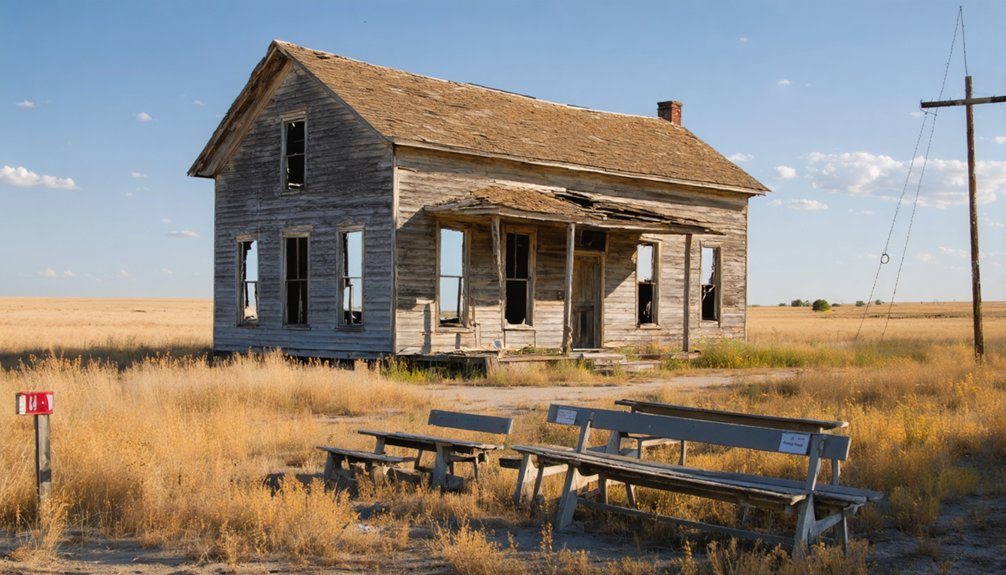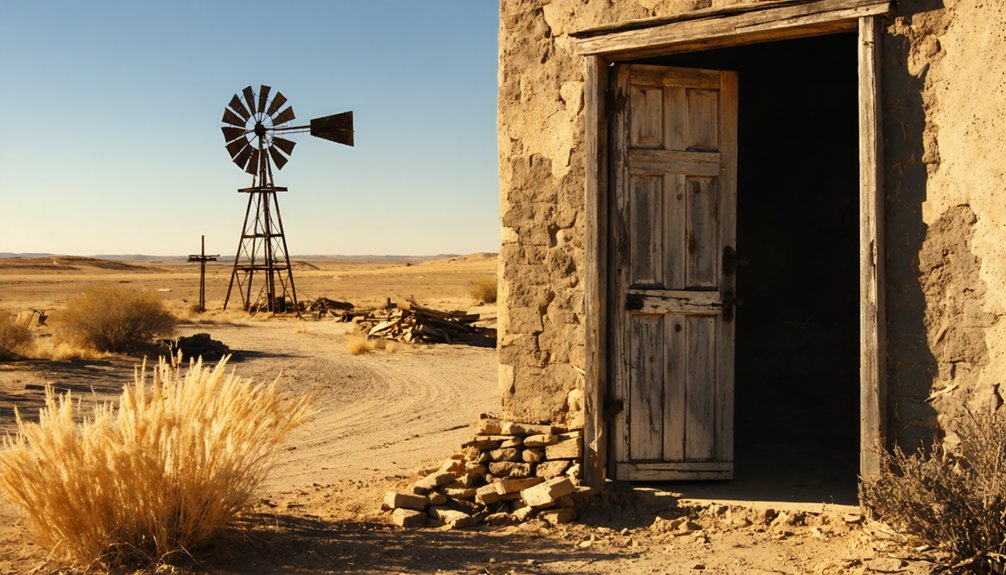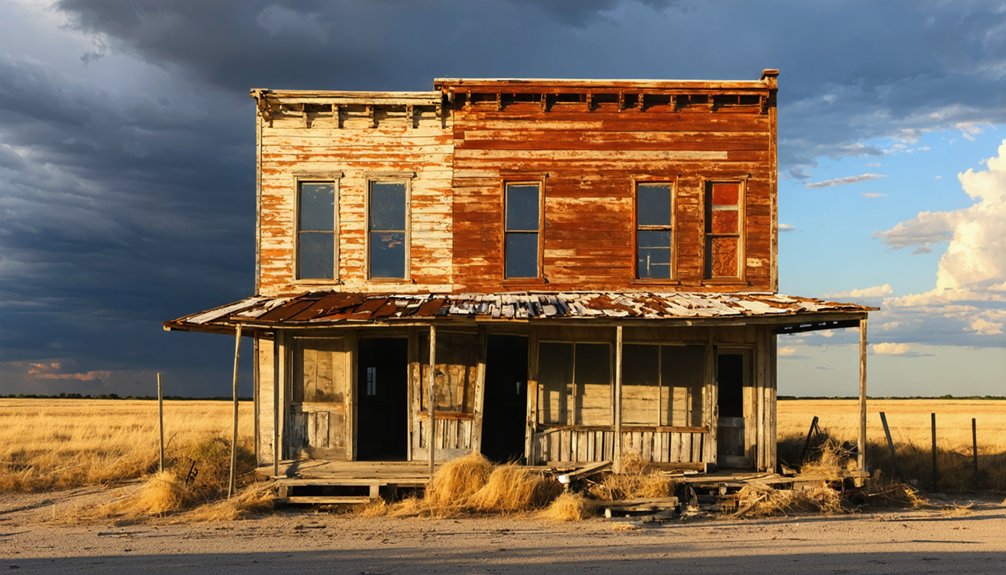You’ll find Estacado’s ghostly remains on Texas’ South Plains, where Paris Cox established the region’s first Quaker colony in 1879. Originally named Marietta, this ambitious settlement served as Crosby County’s first seat and grew to 200 residents. The town’s prominence faded after losing its county seat status in 1890, but its pioneering spirit lives on through its educational legacy and the story of determined settlers who braved the harsh Llano Estacado plateau.
Key Takeaways
- Originally named Marietta, Estacado was founded in 1879 by Paris Cox and Quaker families on Texas’s Llano Estacado plateau.
- The town reached its peak as Crosby County’s first county seat in 1886, serving judicial functions for ten surrounding counties.
- Estacado’s decline began after losing county seat status to Emma around 1890, followed by the Quaker colony’s disintegration by 1893.
- Environmental challenges, including limited rainfall and tensions between farmers and cattle barons, contributed to the settlement’s abandonment.
- The ghost town’s legacy includes establishing the first college on Llano Estacado and pioneering Anglo settlement in Texas’s South Plains.
The Quaker Vision: Birth of a Plains Settlement
When Paris Cox led a group of Quaker families to establish Estacado in 1879, he envisioned creating more than just another settlement on Texas’s South Plains.
You’ll find that Cox’s careful selection of the site, after consulting buffalo hunters and surveying the vast terrain, reflected the Quaker governance principles of thoughtful planning and community resilience.
He secured 812 sections of railroad land from Texas, initially naming the settlement Marietta after his wife before changing it to Estacado. The early settlers endured significant hardships during their first winter, living in primitive tent shelters. The community achieved a milestone when they established their post office in October 1881.
From Marietta to Estacado: A Name’s Evolution
The story behind Estacado’s name holds a personal connection to its founder’s family. Paris Cox initially named the settlement Marietta to honor his wife Mary, reflecting the deep personal investment in this frontier community.
Yet, name significance would soon clash with postal challenges.
You’ll find that by 1881, the settlement’s growth demanded its own post office. However, another Texas town had already claimed the Marietta name, forcing the pioneers to seek an alternative. Just like Estacado’s situation, the town of Oak Ridge faced a similar fate when it was renamed to honor Newt’s wife Marietta.
They turned to their surroundings for inspiration, choosing Estacado after the vast Llano Estacado plateau that defined their landscape. The post office officially opened under this new name on October 13, 1881, marking the shift from a personal tribute to a geographical identifier that better reflected the settlement’s place on the Texas plains. The community continued to grow and was designated as the county seat of Crosby in 1886.
Life and Culture in Early Estacado
The Quaker settlers who founded Estacado brought their distinct religious values of simplicity, education, and community cooperation to shape daily life on the Llano Estacado plains.
You’ll find evidence of their practical approach in the meeting house they built in 1884, which served dual purposes as both a place of worship and the community’s first formal school.
Their emphasis on education and religious instruction made the meeting house a central hub of cultural activity, where Emma Hunt taught some of the earliest classes to the settlement’s children. The harsh conditions they faced included yearly rainfall of only fourteen to twenty-three inches, making agricultural pursuits particularly challenging.
Quaker Values Shape Community
Founded in 1879 by Paris Cox and his fellow Quakers, Estacado emerged as a demonstration of Friends’ principles of peace, equality, and simplicity.
You’ll find these Quaker principles reflected in every aspect of the settlement, from their modest dugout homes to their cooperative farming methods. The community’s egalitarian governance emphasized consensus-building and transparency, while their educational commitment led to the establishment of both basic schooling and the Central Plains Academy. The first classes were taught by Emma Hunt in a dirt dugout.
You can trace their dedication to peaceful coexistence in how they managed the county seat, serving neighboring areas with fairness and integrity. Their agricultural practices showcased community cooperation, with settlers sharing labor and resources rather than competing. The colony purchased 82 sections of land to establish their settlement in the region.
Even the town’s name change from Marietta to Estacado demonstrated their practical approach to problem-solving.
Dual-Purpose Meeting House Legacy
Standing as both a spiritual sanctuary and educational hub, Estacado’s meeting house embodied the practical nature of Quaker settlement life when it opened in late 1884.
Within its modest single-room structure, you’d have found a vibrant center of community cohesion where worship services, school lessons, and civic gatherings seamlessly intertwined.
The meeting house’s educational legacy proved particularly significant. By 1890, it had evolved from informal classes to a proper public school with two teachers and 32 pupils. Like the later Friendswood Friends Church, this building served as both a spiritual and educational cornerstone for its Quaker community.
This commitment to learning culminated in the Central Plains Academy, the first college on the Llano Estacado. Though the academy operated briefly, it established the region’s enduring dedication to education.
Even after Estacado’s decline, the meeting house’s dual-purpose model influenced how other frontier settlements approached community building.
The Rise and Fall as a County Seat
When Crosby County formally organized in 1886, officials designated Estacado as its first county seat, marking a pivotal moment for this Quaker settlement.
You’ll find that Estacado quickly grew in regional importance, serving judicial functions for ten surrounding counties. A new courthouse, built two years later, became the center of local government as the town’s population swelled to 200 residents.
However, Estacado’s political significance proved short-lived. Around 1890, the town lost a critical county seat election to nearby Emma, triggering a swift decline. By 1910, Crosbyton became seat as the county continued evolving.
As the courthouse and government functions moved away, businesses shuttered and families departed. By 1893, the original Quaker colony had disintegrated, and Estacado’s brief reign as a county power center came to an end.
Education on the Frontier Plains

The earliest frontier education in Estacado began modestly in dugout classrooms in 1882, where you’d find local Quaker settlers teaching basic literacy to small groups of students.
You’ll discover that Central Plains Academy emerged from these humble beginnings in 1890, becoming the first college on the Llano Estacado frontier despite lasting only two years. The institution demonstrated the region’s community-driven support through local fundraising and volunteer efforts.
If you’d studied there, you’d have joined just six initial pupils in a shared community meetinghouse, where devoted Quaker educators combined religious principles with formal academics despite the harsh frontier conditions.
Early Teaching Challenges
Despite primitive conditions in 1882, frontier education in Estacado began taking shape through determined educators like Emma Hunt, who established her first classroom in a basic dugout structure.
You’ll find that teacher recruitment proved exceptionally challenging, as qualified educators hesitated to relocate to such remote outposts where they’d face isolation and harsh living conditions.
Those who did accept teaching positions confronted significant curriculum challenges, having to manage multiple grade levels simultaneously while working with minimal resources.
They’d need to adapt their teaching methods to serve about 32 students by 1890, focusing on practical skills suited to frontier life.
Beyond basic literacy and arithmetic, educators incorporated religious instruction, particularly in Quaker meetinghouses that doubled as classrooms, reflecting the settlement’s strong spiritual foundation.
Academy’s Brief Rise
Motivated by their religious and educational values, Quaker settlers established Central Plains Academy in Estacado during 1890, marking a significant advancement from their earlier single-room schools.
You’ll find the academy’s achievements reflected in its extensive curriculum, which blended general education with moral teachings while preparing students for frontier life and community leadership.
The academy’s community impact extended beyond basic education, serving as a cornerstone institution that strengthened the Quaker settlement’s identity.
As one of the first formal educational establishments on the Llano Estacado, you’d have seen dedicated teachers from within the Quaker community working to provide both secondary and post-secondary instruction.
Despite the challenges of limited resources and harsh frontier conditions, the academy demonstrated the settlers’ unwavering commitment to structured higher education in this remote Texas plains region.
Tensions Between Farmers and Cowboys
During the 1880s, rising tensions between farmers and cowboys erupted across Estacado as wealthy cattle barons began enclosing vast stretches of open range with barbed wire fencing.
As cattle prices soared from $7 to $25 per head, wealthy ranchers monopolized essential water sources and grazing lands, leaving small farmers and cowboys struggling to survive.
Farmer resistance and cowboy solidarity emerged through organized fence-cutting movements that fought against land monopolies:
- Groups like the Owls and Blue Devils formed vigilante gangs to cut fences.
- Poor farmers, landless cowboys, and marginalized populations united in protest.
- Cattle barons retaliated with armed thugs against fence cutters.
- Small settlers faced displacement as they lost access to communal grazing areas.
The conflict transformed Estacado’s social fabric, forcing many residents into tenant farming or migration.
The Legacy of Texas’ First South Plains Colony

When Paris Cox established Estacado in 1879 as the first Anglo settlement on Texas’ South Plains, he laid the groundwork for a pioneering Quaker colony that would shape the region’s development.
You can trace the Quaker influence through their commitment to education, establishing the first college on the Llano Estacado and fostering organized schooling that began in dugout classrooms.
Despite settlement challenges like living in sod houses and hauling lumber from distant Colorado City, the colony grew to 200 residents by 1890.
As county seat, Estacado served as a judicial hub for ten surrounding counties.
Though the town declined after losing its administrative role in 1890, its legacy lives on through its educational foundations and role as a proving ground for South Plains settlement.
Frequently Asked Questions
What Happened to the Original Quaker Families After Estacado’s Decline?
You’ll find that Quaker migration patterns show families either returned to their home states, moved to nearby growing towns like Lubbock, or integrated into other South Plains communities, while maintaining their Estacado family legacies.
Were There Any Notable Outlaws or Criminal Incidents in Estacado?
You’ll find little direct evidence of outlaw history in Estacado itself, though Comancheros operated nearby, trading stolen cattle and horses through established meeting points on the Llano Estacado during settlement years.
What Natural Disasters or Weather Events Affected the Settlement?
Like a parched throat in the desert, severe drought impacts constantly challenged your survival there. You’d battle harsh winters, destructive windstorms, and extreme temperature swings, though major flood events weren’t documented.
How Did Native American Tribes Interact With the Estacado Settlement?
You’ll find tribal relations were complex, with Comanche tribes initially resisting settlement but later engaging in limited cultural exchanges through trade with settlers and Comanchero merchants crossing the Llano Estacado region.
What Crops Were Most Successfully Grown by Estacado’s Early Farmers?
Like hitting the agricultural jackpot, you’d find cotton was king, followed by corn and grain sorghum. Despite limited irrigation techniques, these crops thrived through smart crop rotation in Estacado’s well-drained sandy soil.
References
- https://cowboykisses.blogspot.com/2014/10/ghost-town-of-staked-plain-estacado.html
- https://www.lubbockonline.com/story/lifestyle/columns/2017/05/06/caprock-chronicles-booming-estacado-first-county-seat-crosby-county/14825430007/
- https://sites.rootsweb.com/~txcrosby/estacado/history.htm
- https://www.ghosttowns.com/states/tx/estacado.html
- https://victoriaadvocate.com/2010/01/28/estacado-community-almost-gone-but-not-forgotten/
- https://en.wikipedia.org/wiki/Estacado
- https://www.texasescapes.com/TexasTowns/Estacado-Texas.htm
- https://www.hmdb.org/m.asp?m=106238
- https://www.lubbockonline.com/story/news/history/2025/07/18/caprock-chronicles-central-plains-academy-grads-left-lasting-legacy-estacado-texas-quakers/85251256007/
- https://www.tshaonline.org/handbook/entries/religious-society-of-friends



